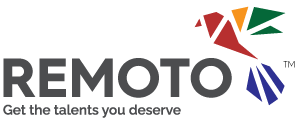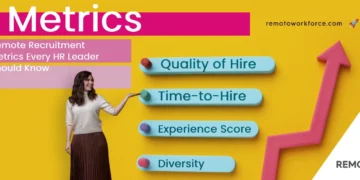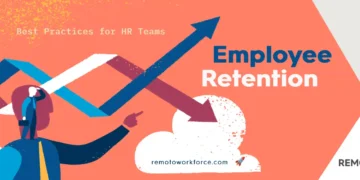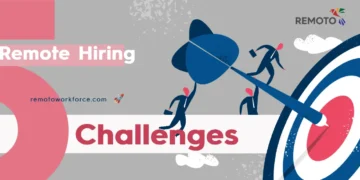Remote work has changed the rules of recruitment and retention. Companies that once relied on location as a filter now face a vast global talent pool. Competition for the best people continues to rise. To succeed, hiring managers must move beyond traditional tactics.
This blog post outlines how companies can design effective recruitment strategies and turn new hires into long-term, engaged team members. The goal is simple: attract, hire, and retain remote talent that contributes meaningfully and remains invested.
The Talent Magnet: Recruiting With Purpose and Precision
Recruiting remote workers begins with understanding what they value. Flexibility ranks high, but candidates also look for clarity, autonomy, and a path for growth. Companies that align with these expectations stand out.
Job descriptions must reflect how the team operates remotely, define what success looks like, and explain how collaboration flows across time zones.
Visibility alone is not enough. Teams must actively source talent on platforms that match their culture and hiring goals. Niche communities, targeted job boards, and professional networks allow hiring teams to reach candidates who align with both role requirements and company values.
Reputation plays a key role in a candidate’s decision. People research companies before applying. They look for a healthy culture, honest leadership, and reliable remote operations.
Employee testimonials, thoughtful LinkedIn updates, and clear career pages all provide signals. Winning top talent requires more than a paycheck. It requires consistency, transparency, and intention.
From Offer to Onboarding: Creating a Seamless Start
Once the right person accepts the offer, the onboarding experience must be smooth and engaging. Remote employees need more than login credentials and digital paperwork. They need structure, support, and a sense of belonging from day one. Onboarding should offer a guided journey that introduces workflows, sets expectations, and builds relationships.
Each new hire benefits from a roadmap. That includes a timeline for meetings, early objectives, and access to documentation that explains how the company works. Onboarding should also include personal connections.
Virtual coffee chats, welcome calls, and mentor pairings help create trust. These touchpoints ease the transition and reduce the isolation that remote work can sometimes cause.
Support does not end after the first week. Strong onboarding continues through the first few months. Regular check-ins give managers the opportunity to address questions, clarify expectations, and build rapport. When onboarding feels intentional, people feel valued. They adapt faster and contribute more confidently.
Keeping Momentum: Building a Culture That Sticks
Remote culture does not happen on its own. Teams must create rhythms that promote trust, communication, and shared purpose. That begins with intentional communication. Teams need consistent tools and processes that make collaboration feel natural, even across time zones. Informal conversations also matter. Without them, culture becomes mechanical.
Distributed teams perform better when they meet regularly in meaningful ways. Weekly syncs, project reviews, and team retrospectives maintain focus and connection. Virtual spaces for non-work chat and casual recognition also support culture. They help people feel like part of something larger than their screen.
Access builds inclusion. Everyone on the team should understand decision-making processes, reporting lines, and expectations.
When people feel included, they participate more. Transparency, paired with accountability, creates a culture where people trust each other and focus on shared outcomes. Culture needs nurturing. It grows through daily habits, not just corporate values on a slide.
Engagement Over Time: Retaining Talent With Care and Clarity
Retention starts long before a resignation letter arrives. It begins with regular dialogue, career alignment, and a sense of progress. Managers who stay close to their teams understand evolving needs and can act before dissatisfaction grows. Engagement is not a one-time campaign. It lives in small, steady moments.
Professional growth often drives long-term retention. Remote workers want to know they have room to grow even when working away from headquarters. Offering development programs, mentoring, and opportunities to lead projects signals trust. When growth aligns with business goals, people stay invested in both their role and the company.
Recognition matters even more in remote settings. Without visibility, people feel overlooked. Consistent acknowledgment of contributions, project milestones, and peer feedback helps employees feel seen.
Public praise during meetings or shout-outs on internal platforms can reinforce value and effort. When employees feel appreciated and challenged, they are far less likely to look elsewhere.
Leading With Intent: Managing Teams Across Time and Place
Remote leadership requires clarity, empathy, and action. Good managers provide guidance, but great managers also create space for autonomy. That means setting priorities and trusting team members to deliver. Leadership in remote environments should promote both accountability and respect for personal work styles.
Emotional awareness becomes essential when body language and spontaneous conversation are no longer available. Managers need to ask good questions, schedule check-ins, and listen carefully. These one-on-one conversations help uncover roadblocks and offer insight into team health. They also build personal connections that fuel long-term trust.
Consistency builds confidence. Leaders must model communication, feedback, and boundaries that support sustainable performance. They influence how teams handle pressure, resolve conflicts, and celebrate wins. A leader’s presence should bring stability, not surveillance. When leadership sets a steady tone, the team follows with confidence.
Long-Term Success Is a Team Sport
The remote workforce continues to grow, and expectations continue to evolve. Companies that want to attract and retain high-performing teams must rethink each phase of the employee lifecycle. That begins with targeted recruitment and continues through structured onboarding, meaningful culture, and intentional leadership.
Success does not depend on tools alone. It takes systems designed for people. Every meeting, document, and conversation shapes the employee experience. Companies that treat remote work as a human challenge rather than a technical one will gain the most from their teams.
Strong retention comes from care, clarity, and consistency. Hiring well is only the first win. Supporting people, growing with them, and giving them a reason to stay—that is what separates remote teams that last from those that fall apart. With the right strategies in place, distance becomes a strength, not a weakness.














